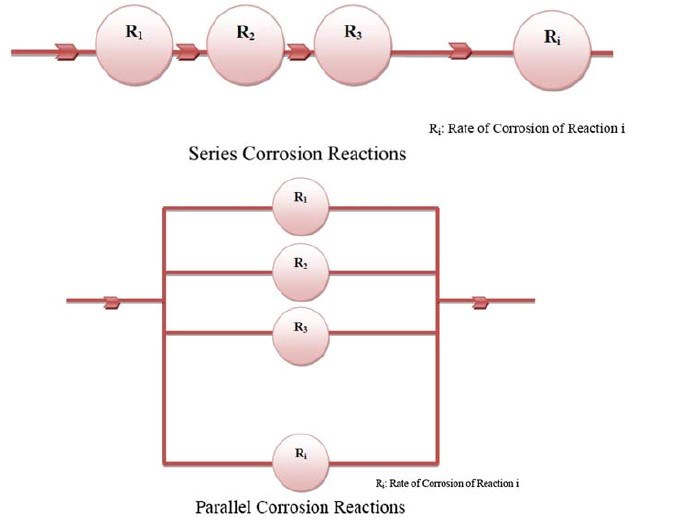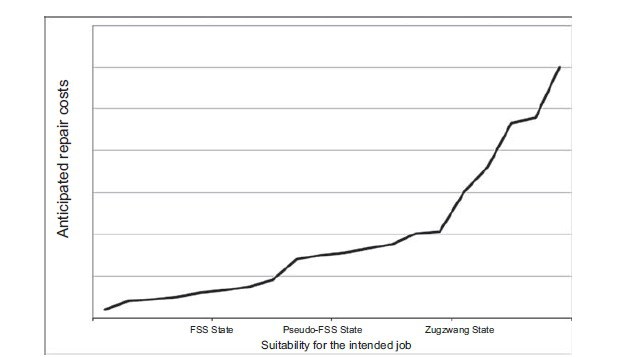In part two of this article, Reza Javaherdashti speaks to Stainless Steel World Americas about the different types of corrosion attacks caused by MIC, preventative and controlling measures, and why trainings on MIC are of the utmost importance.
By Brittani Schroeder
Corrosion attacks
Microbial corrosion (MIC) can contribute to several types of corrosion attacks. These can include pitting, stress corrosion cracking (SCC), crevices, and fatigue. “When MIC presents itself as pitting, if the pits connect with each other they will produce cracks, and therefore SCC would be highly likely to appear as well,” says Javaherdashti. MIC can make it easier for other corrosion processes to occur, because the material is already weak – from a mechanical integrity point of view. If the process conditions already lead to SCC, and bacteria are added to the mix, the SCC is likely to be enhanced by the impact of some bacteria.
“In my corrosion lectures, I like to talk about two terminologies I created to assist integrity engineers and corrosion engineers to better analyze cases of corrosion. There can be two types of corrosion reactions occurring: a series corrosion reaction, and a parallel corrosion reaction,” explains Javaherdashti. “We learn about this in high school in terms of electrical circuits. In a corrosion process, we can see that a corrosion reaction will be enhanced by another series of corrosion reactions. Whereas, in a parallel corrosion reaction pattern, all the reactions are happening independently.” In a series corrosion reaction, once the root problem is understood, it is easier to treat them all simultaneously. If the reactions are in parallel topology, however, each reaction needs to be treated separately. Figure 1 shows how these two corrosion topologies can be defined.

Preventative measures
Javaherdashti stresses the importance of differentiating between corrosion prevention and corrosion control. “When a project is in its greenfield stage – either its conceptual design or within its first year of operation – there is still a chance of preventing corrosion. Materials, designs, and operation parameters such as temperature, velocity, and pressure, can be changed. But when the plant has been operating for many years, and can be referred to as a brownfield project, corrosion prevention makes no sense, mainly because plant management cannot easily agree to replace or change materials, designs, parameters, etc.,” he explains. When a project is considered brownfield, corrosion control is the only thing that can be done.
In order to attempt corrosion control, measures must be thought of that are applicable to the process and material to contain the corrosion. These measures can be separated into five categories: electrical protection, physical protection, chemical protection, mechanical protection, and design protection.
In electrical protection, anodic or cathodic protection can be applied to control the corrosion. Physical protection is the application of paints and coatings. “If an anti-bacterial paint or bacteria-resistant coating are used, this method could work to control corrosion. However, if a polymer coating is used, and its structure is similar to natural polymers, such as starch, then it is highly likely the coating itself will be consumed by bacteria,” relays Javaherdashti. Chemical protection is the application of biocides, which are chemicals that will kill bacteria. These may have an effect on bacteria, but results may vary. Mechanical protection can only work on pipelines, and a great example of this protection is PIGS. A pipeline inspection gauge (PIG) runs through the pipeline to remove biofilms inside the pipe, which then decreases the likelihood of MIC. Javaherdashti continues, “If pigging is not done correctly, or the pigging is not followed by the application of a biocide, then ‘regrowth’ will occur, and the biofilms will restructure itself to become a problem again.” The fifth protection measure, design protection, could also include material selection. This could include, for example, replacing 304 stainless steel with 316 or 2205 duplex stainless steel. “The design of the part can be modified to avoid the formation of conditions that will lead to the creation of an environment with stagnant water, and thus increase the likelihood of MIC,” Javaherdashti says.
New technologies
As the topic of MIC becomes more prominent, new technologies have been introduced to help fight the problem. “We have been seriously considering the possibility of using a biological treatment for MIC. Bacteria can actually be guided to fight against the bacteria that facilitates MIC. Another example of a new technology is coatings that contain positively-charged and negatively-charged areas on their surfaces,” explains Javaherdashti. When bacteria, which are negatively charged particles, want to approach the regions that are positively charged on the coatings, their interaction will end up destroying the bacteria. He continues, “There is no way to say that any of these technologies are 110% reliable, because they all have their limitations. But I am optimistic about the future in regard to new technologies being developed for both treatments and recognition of MIC.”

Equipment life expectancy
In order to know a piece of equipment’s life expectancy after MIC has occurred, the corrosion rate needs to be determined first. If a piece of steel has a thickness of 1 millimeter, and the experienced corrosion rate is 0.1 millimeter per year, within 10 years that piece of metal will be corroded away. However, if there are uncertainties involved, that life expectancy could be further dropped to eight years. “With MIC, we have seen an average corrosion rate of 1.8 millimeters per year, but in some cases, it can be 10 millimeters per year. One case, in Australia, was a flow line with a life expectancy of 20 years,” Javaherdashti recalls. “However, sulfate reducing bacteria were present, and the life expectancy dropped to three to five years.” Therefore, if MIC is present and active in a system, the expected service life will be highly reduced. Many industries have a risk-based inspection (RBI) in place, but Javaherdashti says there needs to be a powerful, knowledgeable, up-to-date, well-trained risk-based assessment (RBA) in place to properly identify MIC.
Javaherdashti also explains the relevance of the German term ‘Zugzwang’ in relation to material’s life expectancy. “The term Zugzwang comes from a chess term, where whatever move you make, you are doomed to fail. I have applied the Zugzwang term to corrosion management. The Zugzwang effect in corrosion management indicates that equipment can reach a point where doing a repair will not be economically feasible,” he explains. “You get stuck in a never-ending cycle of repairs, and it will always result in a failure.” The time between fit for service (FFS) state of equipment and the Zugzwang effect state could become very short due to presence of factors such as MIC. This theory can be explained in Figure 2.
In terms of whether or not equipment needs to be repaired or replaced, Javaherdashti says it depends on the situation. If there is a sensible inspection and corrosion monitoring system in place, most times a repair can take place and corrosion control can be achievable and quite useful. If there is not a proactive corrosion monitoring system in place, and the damage is beyond a certain point, then unfortunately the equipment will need to be replaced. However, simply replacing the material will not be enough. “If the working conditions are still allowing MIC to happen, replacing the material will only delay failure, which wastes time and money. Therefore, before consideration of any replacement, the operation or working conditions need to be reassessed,” Javaherdashti states.

The knowledge gaps
There is a large gap between knowledge and practice throughout many industries when it comes to MIC. “What I have noticed is that many industries are mainly interested in sticking to the rules and regulations that have been used for many years, and very few industries are open to practicing new methodologies to understand MIC and its treatment,” relays Javaherdashti.
Misconceptions about MIC can range from the effect that cathodic protection could have on supressing MIC, to stainless steels being immune to MIC, to certain practices, for example, where the application of copper can prevent MIC, and so on. For Javaherdashti, the main misunderstanding he sees is operators overlooking MIC, or pouring chemicals on it, and believing the problem is gone. “When we underestimate MIC, and treat it as any other type of corrosion, most times the case will worsen and will cause further damage to a system. I once had a client who made a structure of steel, and they believed that by putting coating on it they had taken care of the corrosion. However, we found that in less than a year there were several severe types of pitting occurring, and it was due to the effect of bacteria.” This is just one of the many reasons that Javaherdashti recommends trainings above all else. “Without training, MIC will keep happening and failures will repeat. It is sad to see because I know it could have been prevented via controlling MIC.”
Finding the time for training
In the past two decades, industries have seen many ups and downs, and Javaherdashti has seen more and more training programs being cut due to this. “When I bring up the possibility of hosting an MIC training course, companies give two types of responses: they either already ‘know enough’ about MIC, or they do not have the budget for any MIC trainings,” relays Javaherdashti. “Some companies are happy to continue with what they know, rather than updating practices.”
Javaherdashti urges national associations such as NACE (National Association of Corrosion Engineers), ACA (Australian Corrosion Association), and the U.K. Institute of Corrosion, to offer courses on MIC alongside their regular corrosion training courses. “If well-known associations start offering these courses, industries may finally recognize the importance of being trained on these topics,” explains Javaherdashti.
Javaherdashti’s training courses evolve around two subjects: corrosion management and MIC. “I do these trainings on two levels, introductory and advanced. The introductory course takes about three days to complete, eight hours per day; the advanced course is completed in two days. I start by defining corrosion, what are the thermodynamics behind it, what are anodic and cathodic reactions, and so on,” says Javaherdashti. “I cover many topics and explain everything in full detail. The goal is to give attendees useful, relevant, and practical information so they can bring that back to their company.” Javaherdashti also delves into the microbiology science behind MIC and speaks about under what circumstances MIC will present itself. The pros and cons of each treatment method will also be taught, as will the myths that surround MIC.
“During the introductory level of MIC training course, I give my audience brainstorming sessions where I will present real world case studies, which helps the engineers learn and understand what I am teaching them. Being able to relate past experiences to what I am teaching has been helpful in the past as well,” relays Javaherdashti.
Final thoughts
One of Javaherdashti’s biggest hopes for the future is that the science behind stainless steels and other metals will change to allow for more microbial corrosion-resistant alloys that are affordable to purchase. “I know we have a very long way to go on this goal, but I think it is worth it. Stainless steels, all classes, are vulnerable to MIC, and there must be a way around this,” he says. Javaherdashti also believes that the research on MIC being done across the globe, in various industries, is not enough and it is not making a big enough impact on engineers. “There is more to be done before the problem of MIC is completely understood and controllable. We need to recognize that MIC is a very serious issue, because it also consumes money, and it can cause disasters if we do not have enough knowledge about it. The time to learn how to contain it is now, before a regrettable accident occurs.”

